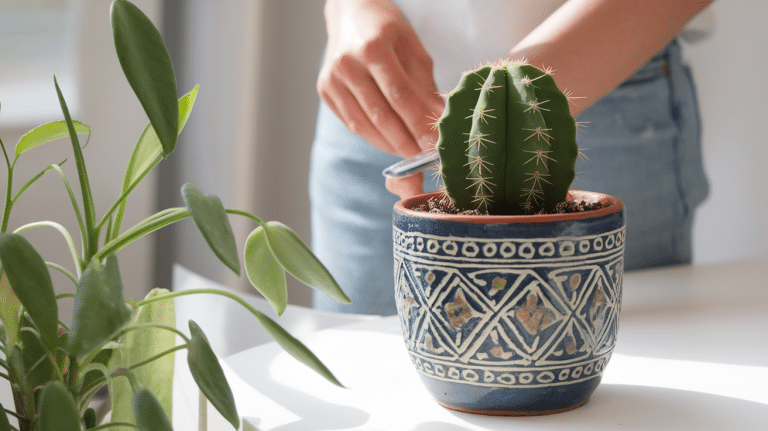Caring for cacti may seem simple—they’re tough desert plants, after all. But the truth lies in finding the perfect balance of moisture.
Many new cactus owners struggle with this fundamental question: How often should I water? Too much water drowns the roots, while too little leaves your plant parched and stressed.
This guide will walk you through the essentials of cactus watering, from recognizing thirst signals to adjusting for seasonal changes.
You’ll learn to read your plant’s needs, avoid common mistakes, and develop a watering rhythm that keeps your cactus thriving year-round.
With these straightforward tips, you’ll gain the confidence to provide just the right amount of water at just the right time.
Why Watering is Crucial for Cactus Health
Proper watering sits at the heart of cactus care. These plants have built-in water storage abilities that help them live in dry places, but they still need the right amount of moisture to stay healthy.
Finding the balance between too much and too little water is crucial for keeping your cactus strong and growing.
When you water correctly, you help your plant build a strong root system and maintain its stored water at a healthy level.
The Water Balance: Overwatering vs. Underwatering
Cacti face risks from both too much and too little water. Finding the sweet spot between these extremes is key to keeping your plant healthy.
Overwatering creates soggy soil where roots can’t breathe, leading to root rot and fungal growth. Watch for soft, discolored spots at the base – early warning signs of trouble. Once rot takes hold, saving the plant becomes difficult.
While less immediately harmful, underwatering causes its problems. Stressed cacti show wrinkling, shrinking, and color changes. Over time, growth stops, and the plant weakens, becoming more vulnerable to pests and disease.
The solution is simple:
- Wait until the soil has completely dried out before watering thoroughly.
- During growing seasons, this might mean watering every 2-4 weeks, while dormant periods require even less frequent attention.
- By paying attention to your plant’s signals, you’ll find the right balance.
How to Know When Your Cactus Needs Water
Knowing when to water your cactus comes down to watching for key signals from both the plant and soil.
Unlike typical houseplants, cacti thrive when allowed to dry out between waterings.
Check the Soil
The most reliable way to tell if your cactus needs water is the finger test. Insert your finger about an inch into the soil – if it feels completely dry, it may be time to water.
This direct check is more dependable than just looking at the surface, as soil can appear dry on top while still holding moisture below.
Signs of Thirsty Cactus
A cactus that needs water will show subtle physical changes. Watch for slight wrinkling or shriveling of the skin as the plant uses its stored moisture.
The cactus might also appear less plump than usual or take on a slightly faded color. These visual clues indicate your plant is ready for a drink.
Monitoring Soil Dryness
The drying period between waterings is essential for healthy cacti. Make sure the soil dries completely before watering again—typically every 10-14 days in warm growing seasons and only every 4-6 weeks during cooler months when growth slows.
Proper cactus soil with extra sand and rocks helps achieve this important drying cycle.
How Often Should You Water Your Cactus?

Finding the right watering schedule for your cactus depends on several factors, with the seasons playing the biggest role.
Unlike most plants, cacti have adapted to going long periods without water, making their care needs quite different from those of other houseplants.
Spring and Summer (Growing Season)
During the warmer months, when your cactus is actively growing, it needs more frequent watering.
Water your cactus every 2-4 weeks during spring and summer, but always check that the soil has dried completely first. Some experts suggest waiting until the soil has been dry for a few days before watering again.
When you water, please give it a good soak until water runs from the drainage holes and allow all excess water to drain away.
Fall and Winter (Dormant Season)
As temperatures drop and daylight shortens in fall and winter, cacti enter a rest period. During these dormant months, cut back watering to once a month or even less.
Some desert cacti might need water only every 6-8 weeks during winter. This reduced schedule prevents root rot when the plant isn’t using much water for growth: the cooler the temperature, the less water your cactus needs.
Factors that Affect Watering Frequency
Your specific situation will change how often you need to water. In humid areas, cacti may require less frequent watering since they can absorb some moisture from the air.
Conversely, in dry, hot climates, you might need to water slightly more often. The pot material matters too – clay pots dry out faster than plastic ones.
Pot size and soil type also play roles, with larger pots and soil containing more organic material retaining moisture longer than small pots with sandy, fast-draining soil.
Best Practices for Watering Cactus
Watering a cactus properly isn’t just about timing—the method matters as much.
Following these simple techniques helps ensure your cactus gets exactly what it needs without risking its health.
1. Watering Technique
When it’s time to water your cactus, do it thoroughly rather than with small sips. Pour water slowly around the base of the plant until it begins to flow from the drainage holes at the bottom of the pot.
This deep watering ensures that all the roots receive moisture and encourages them to grow downward for better stability. The goal is to wet all the soil in the pot, not just the surface layer.
2. Drainage Is Key
Using a pot with good drainage holes is essential for cactus health. These holes allow excess water to escape, preventing the deadly problem of soggy soil and root rot.
If you have a decorative pot without holes, use it as a cover pot with a plastic nursery pot (with holes) inside.
After watering, wait 10-15 minutes, then empty any water that collects in the outer pot or saucer. Never let your cactus sit in standing water.
3. Measuring Watering Amounts
For those who prefer exact measurements, a good guideline is to use 1/4 to 1/2 cup of water for small to medium cacti every 1-2 weeks during the growing season.
Larger specimens will need more, but the principle remains the same. This measured approach helps prevent both over- and under-watering, especially for beginners still learning to read their plants’ needs.
4. Avoid Standing Water
After watering, check the bottom of the pot or saucer for collected water and empty it promptly. Standing water can be pulled back into the soil through capillary action, keeping the roots too wet.
If you notice water pooling in the saucer, tip it out immediately. For indoor plants, consider watering in the sink or bathtub, allowing the pot to drain fully before returning it to its usual spot.
Common Mistakes When Watering Cacti
Even the most well-meaning plant owners can make mistakes when watering their cacti. These hardy plants have specific needs that differ from most houseplants, making them easy to mishandle despite their tough reputation.
Understanding these common errors can help keep your desert plants thriving for years.
- Watering on a strict schedule: Instead of watering every Friday, check if the soil is completely dry first.
- Using pots without drainage holes – This traps water at the bottom, leading to root rot.
- Keep cacti in regular potting soil – Standard soil holds too much moisture; use cactus-specific soil that drains quickly.
- Misting cacti – Unlike tropical plants, cacti don’t benefit from misting and may develop fungal problems.
- Forgetting to adjust for seasons – Not cutting back watering in fall and winter when plants are dormant.
- Ignoring humidity levels – Not accounting for how indoor heating and air conditioning affect soil drying.
- Overreacting to slight shriveling – Some wrinkling is normal between waterings and doesn’t mean the plant needs immediate water.
- Using overly large pots – These retain more moisture than the cactus can use, leading to wet soil.
Special Considerations for Different Types of Cacti
Not all cacti have identical water needs. Different species, sizes, and growing environments all play important roles in determining the right watering approach.
Understanding these variations helps you provide the best care for your specific plants.
Small Indoor Cacti
Due to their smaller soil volume, mini cacti require special attention. These tiny plants typically need water every 10-14 days during the growing season, but their small pots dry out more quickly.
The best indicator is weight—a dry pot feels noticeably lighter than a watered one. Use less water, but follow the same rule of waiting until the soil is completely dry. During winter, reduce watering to once every 4-6 weeks to match their slower growth.
Outdoor Cacti
Once established, garden cacti generally need less frequent watering. Their extensive root systems can access moisture from a wider area. Water outdoor cacti about every 2-3 weeks during hot summers, letting natural rainfall help when available.
In winter, most outdoor cacti require no additional water as they enter dormancy. However, to prevent root damage, soil must always be dry before freezing temperatures arrive.
Cacti in Humid Climates
High humidity presents challenges for cacti care. In these conditions, soil dries more slowly, so the time between waterings is often extended to just once a month, even during the growing season.
Focus on good air circulation with fans indoors or strategic placement outdoors. Use extra-sandy soil with added perlite or pumice to improve drainage and offset the effects of humid air.
Tips for Long-Term Cactus Care
Proper watering is just one piece of the cactus care puzzle. Several other factors need attention for your desert plants to thrive over the long term truly.
These simple but important practices help create the ideal growing environment that mimics a cactus’s natural habitat.
- Regular potting mix retains too much moisture; cactus soil with sand, perlite, and small rocks allows proper drainage.
- Terracotta or clay pots help soil dry faster, and all pots should have drainage holes.
- Most cacti need 4-6 hours of direct sunlight daily; rotate them occasionally for even growth.
- Keep cacti away from cold drafts, air conditioners, and heating vents.
- Fresh soil improves drainage and provides new nutrients.
- Feed only during the growing season with diluted cactus fertilizer.
- Look for mealybugs, scale insects, and spider mites, especially in plant crevices.
- Gently wipe larger cacti with a soft brush to keep pores clear.
- Reduce water and fertilizer during dormant winter months.
- Yellowing or browning can indicate watering problems or disease.
Conclusion
Understanding your cactus’s watering needs is the foundation of successful plant care. The key lies in finding balance—waiting until the soil is completely dry before watering and then doing so thoroughly.
Pay attention to seasonal changes, adjusting your routine as your plant cycles between growth and dormancy. Your cactus will tell you what it needs through subtle changes in appearance.
Take a moment each week to check your cactus’s soil moisture. Insert your finger an inch deep, feeling for dryness.
This simple habit, combined with observing your plant’s appearance, will help you develop the perfect watering rhythm for a healthy, long-lived cactus.













